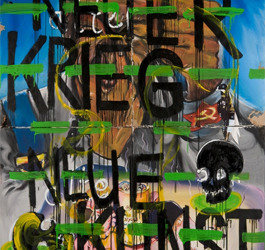Art/Histories
dal 25/7/2014 al 25/10/2014
Segnalato da
Kader Attia
Elias Baeck
Lothar Baumgarten
Alfred Baumgartner
Heimrad Backer
Michael Blum
Marcel Broodthaers
Johann August Corvinus
Alice Creischer
Gerti Deutsch
Otto Dix
Stan Douglas
Harun Farocki
Omer Fast
Ian Hamilton Finlay
Simone Forti
Andrea Fraser
Andrea Geyer
Dan Graham
Renee Gree
Ernst Haas
Jorg Immendorff
Felix Drose
Jorg Immendorff
Sanja Ivekovic
Kurt Kaindl
Gulsun Karamustafa
Anselm Kiefer
Kathe Kollwitz
Christoph Lederwasch
Deimantas Narkevicius
Walid Raad
The Atlas Group
Elaine Reichek
Aura Rosenberg
Martha Rosler
Anri Sala
Andreas Siekmann
Wael Shawky
Chen Shaoxiong
Johann Conrad Stapff
Danh Vo
Lawrence Weiner
Akram Zaatari
Sabine Breitwieser
Christina Penetsdorfer
25/7/2014
Art/Histories
Museum der Moderne, Salzburg
Art that reflects on history and contemporary events as well as its own involvement. With more than 230 works by around 40 artists, the show spans the period from the 17th century to the present. A larger historical framework that surveys its contemporary manifestations.

Artists in the exhibition: Anonym, Kader Attia, Elias Baeck, Lothar Baumgarten, Alfred Baumgartner, Heimrad Bäcker, Michael Blum, Marcel Broodthaers, Johann August Corvinus, Alice Creischer, Gerti Deutsch, Otto Dix, Stan Douglas, Harun Farocki, Omer Fast, Ian Hamilton Finlay, Simone Forti, Andrea Fraser, Andrea Geyer, Dan Graham, Renée Gree, Ernst Haas, Jörg Immendorff / Felix Dröse, Jörg Immendorff, Sanja Iveković, Kurt Kaindl, Gülsün Karamustafa, Anselm Kiefer, Käthe Kollwitz, Christoph Lederwasch, Deimantas Narkevičius, Walid Raad / The Atlas Group, Elaine Reichek, Aura Rosenberg, Martha Rosler, Anri Sala, Andreas Siekmann, Wael Shawky, Chen Shaoxiong, Johann Conrad Stapff, Danh Vō, Lawrence Weiner, Akram Zaatari.
Curator: Sabine Breitwieser, Director together, with Christina Penetsdorfer, Curatorial Assistant, Museum der Moderne Salzburg
How is history written, who is appointed to write it, and which tools do historians apply to the study and evaluation of historical events and the communication of their findings? How about the objectivity of scholarly research and the historic documents on which it is based? What legitimizes visual artists who bring their own resources and unique approaches to the exploration of themes in history and recent historic events in their work?
The first thematic exhibition under the aegis of the museum’s new leadership initiates a debate over a central part of the institution’s mission: making history out of artifacts. Looking beyond the narrow confines of art history, it focuses on works with a specific frame of reference: art that reflects on history and contemporary events as well as its own involvement. With more than 230 works by around forty artists, the show spans the period from the seventeenth century to the present. It engages both the museum’s own and other local collections as well as a variety of perspectives and artistic practices, including the rules of the art world itself, in a dialogue. The exhibition thus presents art with distinctive views on history—and the artists behind it—in a larger historical framework and surveys its origins as well as its contemporary manifestations.
The scrupulous methodology of historiography has recently found itself confronted with a new emphasis on the immediate experience of events. In the last few years, this shift has led critics to raise numerous questions also concerning the role of the museum: Whose history is to be told, and from whose perspective? Whose task is it to tell it? And what form is the ongoing revision of traditional contents to take? A general consensus has emerged that art history should be read less as a linear succession of schools and tendencies spearheaded by individual protagonists than as a living network in which interrelations and meanings are subject to ongoing renegotiation.
Can artists be (critical) historians? Can they tell us something that we do not already know from the profusion of facts and views with which today’s media flood us? Or do we have reason to hope that they are simply “better” at telling us about “their” view of history and histories?
The exhibition is organized by the Museum der Moderne Salzburg.
In conjunction with the exhibition the catalogue Art/Histories has been published by Hirmer Verlag, Munich, with texts by Sabine Breitwieser, Karl-Markus Gauß, Eva Kernbauer, german/english edition, 212 p., softcover, numerous coloured illustrations.
Press & Public Relation
Christine Forstner T +43.(0)662.84 22 20-601 M +43.(0)664.85 49 983 F + 43.(0)662.84 22 20-701 christine.forstner@mdmsalzburg.at
Opening on Saturday, July 26, 2014, 11 a.m.
Museum der Moderne Salzburg
Mönchsberg 32 5020 Salzburg
Hours:
Tuesday - Sunday: 10.00 am - 6.00 pm
Wednesday: 10.00 am - 8.00 pm
Monday closed
Admission
Adults: € 8,-
Seniors: € 6,-
Children (6 to 15 years): € 6,-
Youth (16 to 18 years): € 6,-
Students (to 26 years): € 6,-
Groups over 10 persons: € 7,-/person
Family ticket: € 12,-
min. 1 Adult and 1 child (to 15 Y.)



